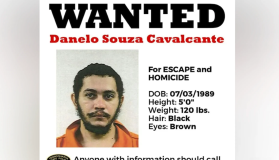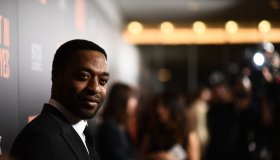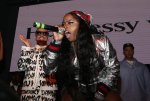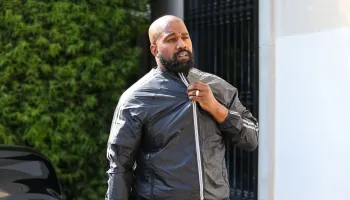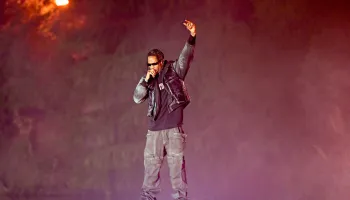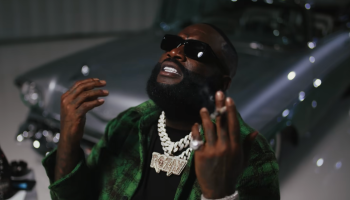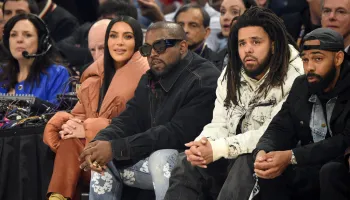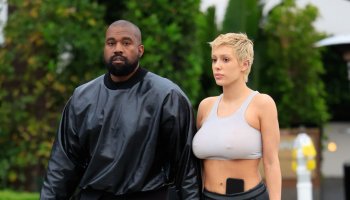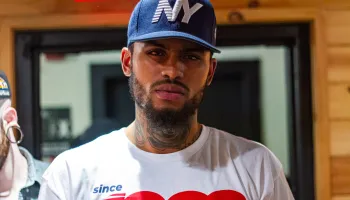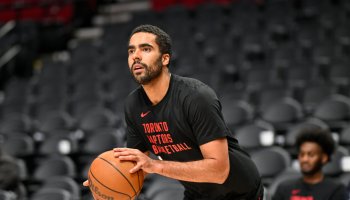
Source: press handout / Sadé Clacken Joseph
When filmmaker Sadé Clacken Joseph was coming of age in the Bronx as a first-generation American in a Caribbean immigrant household, she never would have guessed that her no-nonsense mother would eventually become her biggest cheerleader. Especially while she makes her way in the world as a creative.
And “creative” in her space is more than an overused buzzword in the days of underaged (and too often “overaged”) TikTokers branding themselves as such.
So let’s be clear. Joseph is a photographer, cinematographer, editor, director, producer, filmmaker, singer and songwriter. You may have heard her name before now as she was specially chosen by Issa Rae herself to direct the first two episodes of Rae’s new HBO series, Rap Sh!t, starring Kamillion and Aida Osman as Mia and Shawna. She also acted as consulting producer on the remaining six episodes. The debut season is already half over but the accolades continue to roll in.
Loosely based on the rise of the City Girls (who act as executive producers on the project, along with Kevin ‘Coach K’ Lee and Pierre ‘P’ Thomas for Quality Control Films). It was just last week when Joseph, signed a contract with CAA, positioning her company Out of Many Media to shine even brighter while she awaits the next big opportunity to come her way. And the way it’s all unfolding, that may be a lot sooner than later. “That [phone call from Issa] was a little over a year ago,” she shares. “And it’s been surreal ever since.”
Hip-Hop Wired: A few days before the first episode debuted on HBO Max, there was a video circulating of this white woman rapping and calling herself ‘lightskinned,’ that set social media ablaze. No commentary, no connection to the show at all. Just this random video. It was such a brilliant move on you guys’ part! Very smart.
Sade Clacken Joseph: Yes! Reina Reign! I honestly wasn’t involved in that decisionmaking but our creators are very intentional and very smart. I know we did want to find ways to engage social media in the real world so I’m not surprised.
HHW: The way that you all incorporate that first-person scanning of social media is really dope too. Was the concept already in the script or was it worked out after you had a chance to read it?
SCJ: The use of social media and things already being on the screen was actually in the original iteration of the script. The story was told entirely through social media or device screens and we opened up the world as we developed a pilot and rewrote it but it was still really important to me that social media was still felt heavily in the pilot especially. I really wanted viewers to be engaged with the show in a whole new way, not even realizing how they’re becoming a character in the show through the way the characters were portraying themselves.
I wanted to be able to go in and out of the phone seamlessly and really use the social media as a character and a way of storytelling. The director of photography, Lucas Gath, and I spent a lot of time developing the visual language of the show and deciding: What does the social media world look like?
What does it look like for someone who’s a pro at social media, like Mia? How do we show this through the editing? Through the camera filtration? The color grade… How do we make it look more polished for her?
Versus Shawna’s Instagram videos where she’s not as much of an expert, or in Reina Reign’s world. Or when we’re just with our character and they’re not on social media, they’re just being present with themselves. How does that look?
HHW: I’m sure the technical side of trying to figure this out was insane.
SCJ: We had different cameras based on the different mental states of our characters and whether or not they were aware they were being filmed. I also wanted to show them going in and out of the phone in very specific moments. So like, in the hotel room, you see where she’s doing the daughter’s makeup and we pull out of the phone when she and Mia start having a real moment together.
Or in the [Instagram] Live, when Mia starts getting real with her, we start “pushing in.” When Shawna is being forced to confront herself, we push in and then we’re out of the social media world and in the real world with them. That’s how I wanted the viewer to be engaged. That wasn’t in the script. These were the things I brought in, because I think it matters. I wanted people to think critically as they watched the show.
Like, a lot of the time we’re presenting this version of ourselves to people, but it’s not the reality and how do I show realness? Especially for women and artists like Shawna who are battling how to navigate being true to themselves and their artistry. Or having to change who they are to present themselves a certain way, just to get attention, be seen or just for their music to be heard.
So those were some of the things we were thinking about. Also, our first time actors, Kamillion and Aida, they wore camera rigs. That’s why we have some of those unflattering angles, all up on their faces or underneath where they’re moving around and you can see the phone in their hands. They were actually holding the camera rigs themselves and acting for the first time so that was really challenging, but fun for them.
I have to give them props, because no other show has done this, to that degree and they killed it. They collaborated in that sense with me because they’re the social media experts. So they helped, because I would ask them, “How would you in real life, film yourself?” And we would do it on their phones, play it for the camera people and then we would emulate what they did, with our camera and work with them. So it was a really fun way to collaborate with my talent and come up with this new way of showcasing social media on the show.
HHW: A lot of people online took note of the comments, especially when Mia and Shawna had their moment on Instagram Live…
SCJ: That was fun to work on with the writers too. Even the editor had ideas for that, we wanted the comments to be able to add more to the storytelling. That was fun to play around with…
I’m happy people noticed that because I didn’t think viewers would have realized or been noticing the comments.
HHW: For sure. On Twitter, everyone was tweeting and retweeting that one comment: “Free Tishawn or whatever…”
SCJ: We really wanted the audience to be engaged. We really wanted to guide people’s eyes to different things on the screen at all times. Even what you mentioned about Mia’s ‘likes,’ how do we hone in on the screen to what Shawna’s seeing? When she looks at Mia’s page, what is she really looking at? Using the camera to guide the viewers’ eyes is really important. My creative director and previsual artist, Anthony Harvey also helped a lot with that. He did a lot of renderings and moving tests for us. I’d show these to Issa and Syreeta and they’d be like, “That’s dope.” Then our editor would incorporate it. It was a really big collaborative effort.
HHW: Okay, let’s go back to the very beginning. Describe the day you knew this would be your path.
SCJ: It wasn’t like one day where I was just like, “Oh. I’m gonna be a filmmaker today.” I just started my interest for filmmaking by watching behind the scenes featurettes on my special edition Lord of the Rings DVD sets. I would religiously watch these DVDs and watch Peter Jackson. I would listen to and watch all these department heads and understand the process of filmmaking that way.
I never knew I could be an artist until later in life when I found out about film school and all that stuff. That was seven years ago when I really started really pursuing filmmaking and I told my parents, “This is what I wanna do. Bye.”
HHW: What should we watch for as this season of Rap Sh!t continues to unfold?
SCJ: You can expect a lot more from Chastity [played by Johnica Booth] and how she comes into the mix and represents a whole other type of female empowerment as a queer Black woman. I just love her character so much and how she comes to interact with the group and her storyline. She’s one of my favorite characters. I think people are gonna really love her.
And you can expect a lot of great music. Some wild adventures. Some traveling outside of Miami adventures for the rest of the season, so stay tuned. I’ve got to shout out Raedio for how hard they worked to make sure that Miami’s music was highlighted and we had writing camps where we flew in some of the most talented producers and writers to come up with the sound of the show and the lyrics for the show, like PineappleCITI and Dreezy. My band is on the soundtrack too, B00ty. We actually released “Matter of Time” with Loose Ends and it’s featured on the show!
HHW: Recently you headed up a panel in LA speaking to the underrepresentation of the Afro-Caribbean experience…
SCJ: That was a couple months ago. I did it at Soho House and I’d like to continue doing the series; it’s called The Longing. It features Caribbean artists in Hollywood. I formed my company, Out of Many Media, for that reason — to be a place to help Caribbean filmmakers and help promote Black representation outside of the African-American experience. It’s funny, my mom went from not supporting me at all with this artistic dream to now, like, helping with my company. She helped me come up with the name.
HHW: You met Issa on set while shooting a commercial for Madewell, but you’ve also worked with Google, Spotify, etc… You’ve shot a documentary with TI and Common. How long is your resume right now?
SCJ: I’ve been working at it for a while. I started just freelancing in New York, doing documentaries and photography. I worked my way up. I’ve traveled to Africa and Palestine doing documentaries. I started with documentaries as a background but I come from a music background as well.
Before film, I was songwriting, singing and playing the piano. So finding a way to combine my love of music and documentaries is what led me to work with Common. I worked with him for a really long time starting at USC which led me to directing his music videos and stuff. But everything I do is music driven, or music playing a big role or about musicians or just has a lot of musicality to it and also a really grounded reality about people coming into their own identity.
Just working, having my own production company and being someone who was a shooter, a cinematographer, an editor, a director and producer allowed me to produce a lot of things and get a lot of work. I’ve definitely done my 10,000 hours. It’s been a journey. That’s another thing I could say: Every relationship I’ve had and every job I’ve had, I’ve always had a good attitude. Issa recognized that [at the Madewell shoot where they met and worked together] and thought of me. You never know who’s gonna give you your next job in this industry so reputation is really important.
HHW: What advice would you offer up-and-coming filmmakers with a background similar to yours?
SCJ: You do not need to wait for permission from anyone to pursue your artistry. Know that there is a place for you and your voice matters, people want to hear it and there’s no set path to becoming a filmmaker. There’s film school, yes, that’s great. But I also learned by working on sets, diving in and getting my hands dirty, so I think don’t be afraid to pursue your dreams. There are so many possibilities, different jobs and things to do and explore in this industry.
I encourage you to do as much as you can with them because if you’re even interested in directing, the more you know about all the jobs on set and how to do them all, it makes you an even stronger director. I really encourage people to have an open mind and to humble themselves when it comes to working in this industry. I’d also tell them not to allow anyone to make you feel like you don’t belong because imposter syndrome is so real…
HHW: Right!
SCJ: For us as women, for us as people of color in this industry, especially when you’re directing, you’re on these sets with white men who’ve been directing for decades so it’s really easy to get lost in “Oh. I don’t belong here…” or “They know better than me…” People hire you because they want your eye. Your background and how you see the world is a unique perspective, lean into that and don’t try to assimilate to what the people around you may think is right. Trust yourself and your voice.
